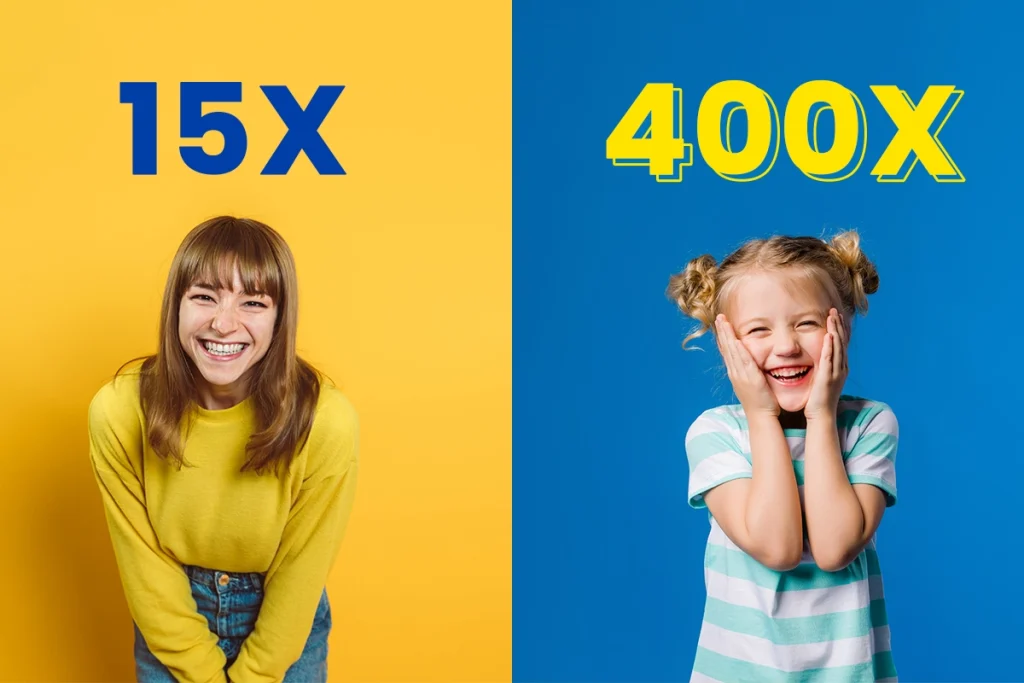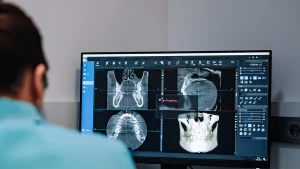Smiling is one of the most frequent expressions we make as humans. According to researchers, a typical adult smiles 15-20 times daily. Children, on the other hand, have a whopping average of 400 smiles a day!

Clearly, we are all very familiar with the expression, but did you know that the humble grin serves a purpose far beyond conveying our mood? Today, we are exploring the power of the smile, from its evolutionary roots to its contemporary effects.
When Did Your Smile Start?
Do you remember when you first learned to smile? That’s a trick question. Contrary to popular belief, humans don’t ‘learn’ to smile. It is an innate ability we are all born with. The first smile you made likely happened when you were still in the womb! That’s right. Evidence shows that we begin smiling as early as 24 weeks gestation.
Like all innate human abilities, the origin of smiling can be found in our evolutionary story. According to primatologist Signe Preuschoft, the smile traces back 30 million years to the “fear grin” of primates, who would bare their teeth to predators to convey they weren’t a threat.
Today, most of us view smiling as an expression to convey happiness. However, this isn’t the whole story. In reality, there are around nineteen different types of smiles, and only six are associated with positive emotions!

So Many Different Types Of Smiles
A few of the most common types of smiles include the flirty smile, the lying smile, the embarrassed smile, and the Pan Am smile. The latter smile describes a fake smile, and it gets its name from the airline that trained its air hostesses always to address customers with a broad, forced grin.
Do you work in customer service? If so, learn from Pan Am’s mistake by always smiling with your eyes and mouth, not just your mouth, as this will make your smile appear more authentic!
So, of all these different types of smiles, which is society’s favorite? That would be the Duchenne smile, also known as the smile of genuine enjoyment. It is the one that involves the mouth, the cheeks, and the eyes simultaneously.
According to the latest research, those who display a Duchenne smile appear more trustworthy, authentic, and friendly to others. They’ve also been found to generate better customer service experiences and higher tips. Furthermore, in a 2009 study, researchers looked at the intensity of smiles in yearbook photos and found that women who had the Duchenne smile were more likely to end up in happy and lasting relationships.
Smiling’s ability to help us make a good impression is believed to be in part due to its contagious quality. When someone sees you smiling, they tend to smile in response. And when they do, the stimulation of the smile muscles releases endorphins that make people feel better. Then, they associate you with feeling good, making them more likely to want to spend time with you.
This research coincides with the findings of Coffee Meets Bagel (CMB), a competing dating app. AT CMB, researchers found that having an open-mouthed smile was important, especially for men.
CMB’s study found that of the men who got “liked” more than 50% of the time, nearly 80% were smiling with their teeth showing, compared to 16% who weren’t smiling and 5% who had a closed-mouth smile.
Smiling Makes You Look Younger
In addition to making us appear more approachable and attractive, smiling also impacts how old we look to others. German researchers studied how accurate men and women were at guessing others’ ages by having them look at multiple photos of the faces of 171 young, middle-aged, and older people. In some of the photos, the faces were smiling. In others, they looked fearful, disgusted, sad, or simply neutral. The study found that people were most likely to underestimate the age of those smiling.
So, what explains a smile’s apparent age-defying effect? The study offered a couple of explanations. First, it can be hard to tell whether the facial wrinkles seen in a smiling face are temporary, the effect of the smile itself, or permanent. Second, smiling may have some “halo effect,” meaning we tend to find smiling faces more attractive, leading us to imbue them with positive effects like youth.
Clearly, smiling significantly impacts how society receives us, but how does smiling affect our internal world? Research has found that smiling has profound effects on our mood.
When you smile, your brain releases oxytocin, serotonin, dopamine, and endorphins, four feel-good hormones that boost happiness. According to neuroscience, smiling lights up the same amount of neurotransmitters in the brain as eating 2000 chocolate bars or receiving $25,000! Now, that’s what we call pure elation!

And don’t worry; you don’t need the gold standard Duchenne style to enjoy these mood-boosting benefits. Studies have shown that the mere muscle movements involved in smiling are enough to trick your brain into releasing these happy hormones, giving new meaning to the phrase ‘fake it until you make it’!
Live Longer Just By Smiling
In addition to benefiting our mental health, smiling has also been found to improve our physical health by boosting our immune system and lowering our heart rate in response to stressful situations.
It’s no secret that stress can wreak havoc on our wellbeing, especially our longevity, which has led researchers to conclude that combatting stress with a smile can add years to our lifespan. American scientists recently studied an old photo of a team of baseball players and found that those who smiled in the shot lived longer. The big smilers lived an average of 79.9 years, the partial smilers got 75 years, and the non-smilers lived an average of 72.9 years. That’s an astounding seven years extra just for smiling more!
Along with being an elixir for a long life, researchers have also found that smiling can help us face physical pain. Through stimulating endorphins in the brain, smiling acts as a mild pain reliever that is so effective that many obstetricians advise moms to smile during their labor and delivery.
Feel-good benefits aside, smiling can also impact your professional life. According to one recent study by the American Academy of Orthodontics, 75% of people who received orthodontic treatment as adults reported growth in their careers.
Furthermore, a team of economists performed a study that found that workers enjoy a boost in productivity, decision-making, and learning due to a release of dopamine triggered by smiling. So, next time you need a pick-me-up at the office, try busting out a toothy grin; it could give you the lift you are looking for!
Smiles Are Like Fingerprints
Now that you have learned the power of a smile let’s discuss your smile specifically, a.k .a. your trademark feature! Studies show that your smile is the most recognizable part of your face. Many people can identify certain smiles from 300 feet away!
If you aren’t convinced, consider all the beautiful smiles you would know from anywhere. From your friends and family to Julia Robert, there are some smiles we can identify in seconds. So, if you ever feel lost in the shuffle, remember that no one’s smile is quite like yours!
So, what does it take to show off your unique smile? You can use more than 50 facial muscles every time you smile. If you have a small, relaxed smile, it might only use 5 muscles to activate. Either way, it is a low-activity workout that offers significant bang for its buck!
Unlike a handshake or a wink, which can have different meanings across cultures, a smile is one expression everyone agrees on and understands. So, does this make it a uniquely human experience? Animal researchers suggest otherwise.
Animals Can Also Smile!
In the animal kingdom, you can see smiles among chimpanzees and apes. Chimps have smiles similar to humans and use their grins to display a range of emotions. There are also some differences, of course. For one, chimps are likelier to smile when threatening someone or expressing danger.
An animal’s smile can also be found closer to home, in the form of a dog’s smile. Social media is full of pictures of man’s best friends appearing to grin. However, dogs don’t smile in the same way as humans. Instead, they can make their faces appear like they are smiling.
This happens when they open their mouths, pull back their lips, and let their tongue lap over their teeth. This “dog smile” often occurs in response to a human smile, which is why owners think their dog is smiling back at them.

Smiling offers a lot of physical, psychological, and social benefits. So, if you have been hiding your grin because you are missing a few teeth or don’t like their shape or color, reach out to us for an evaluation to get you on track to the smile of your dreams.



